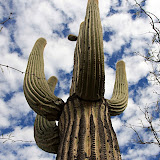 Saguaro National Park (park is divided into two parts, West and East) is very close to Tucson , east from the Tucson Mountains and west of the Rincon Mountains. There is growing ubiquitous symbol of the park - giant cereus - a big cactus kandelabrowy - saguaro. Located on the east Saguaro East - Rincon Mountain District was declared a park in 1933, the aim of this was to protect the extensive "forest" cereusów impressive. However, Saguaro West - Tucson Mountain District was attached in 1961 - for research purposes, to track the growth of young saguaro. In both parts of the National Park - Rincon Mountain and Tucson Mountain scenic route we have a great car, and a variety of hiking trails that traverse the giant cacti.
Saguaro National Park (park is divided into two parts, West and East) is very close to Tucson , east from the Tucson Mountains and west of the Rincon Mountains. There is growing ubiquitous symbol of the park - giant cereus - a big cactus kandelabrowy - saguaro. Located on the east Saguaro East - Rincon Mountain District was declared a park in 1933, the aim of this was to protect the extensive "forest" cereusów impressive. However, Saguaro West - Tucson Mountain District was attached in 1961 - for research purposes, to track the growth of young saguaro. In both parts of the National Park - Rincon Mountain and Tucson Mountain scenic route we have a great car, and a variety of hiking trails that traverse the giant cacti. 
spiny cacti like a giant army of marching troops make an impression with raised arms to fight the hills Sonora. These plants can live for over 150 years, provided that they are warm and have enough water. Their roots take water very quickly during the short rains, which transmits it to the virtually free, woody stems. Handsome specimen collected up to 760 liters, which allows him to survive the drought year.
 Cactus Thorns - erroneously referred to as spikes - it leaves adapted to the difficult climate - summer temperatures reaching nearly 40 C, and frosts occur in winter, to prevent excessive water loss, as well as defend the plant against intruders, it stops the cold night air. Photosynthesis takes place in a green stalk and stems of the main side, covered with wax layer, which protects them against excessive evaporation.
Cactus Thorns - erroneously referred to as spikes - it leaves adapted to the difficult climate - summer temperatures reaching nearly 40 C, and frosts occur in winter, to prevent excessive water loss, as well as defend the plant against intruders, it stops the cold night air. Photosynthesis takes place in a green stalk and stems of the main side, covered with wax layer, which protects them against excessive evaporation.

 here - on the slopes covered with turniami - powulkanicznych mountains, in the shade of trees such as Mesquite and palo verde of the olive tree - grow a small saguaro, which over time turn into giants, evenly distributed for optimal utilization of rainwater. On their shoulders - in the spring appear białokremowe flowers, heavy with sticky dust. Nectar attracts cereusów Molossian Mexican - bats, which flies chmarami whole and on the occasion of pollinating the flowers of cacti.
here - on the slopes covered with turniami - powulkanicznych mountains, in the shade of trees such as Mesquite and palo verde of the olive tree - grow a small saguaro, which over time turn into giants, evenly distributed for optimal utilization of rainwater. On their shoulders - in the spring appear białokremowe flowers, heavy with sticky dust. Nectar attracts cereusów Molossian Mexican - bats, which flies chmarami whole and on the occasion of pollinating the flowers of cacti.  urge to visit the park in late summer to see the ripe, red fruit. Tohono O'odham Indians, who inhabited the desert gather them, and then processed into syrup. Ancestors roamed the desert tribe Tohomo O'odham, Hohokam. Remaining after these petroglyfy on black volcanic rocks, min. near the Signal Hill picnic site.
urge to visit the park in late summer to see the ripe, red fruit. Tohono O'odham Indians, who inhabited the desert gather them, and then processed into syrup. Ancestors roamed the desert tribe Tohomo O'odham, Hohokam. Remaining after these petroglyfy on black volcanic rocks, min. near the Signal Hill picnic site.  Located in the east of Saguaro East is much more varied, and hiking trails are very long and give the opportunity to reach the desert scrub into woodland, and even the mountain forest - from a height 792 to 2,641 m above sea level Hikers can enjoy around 200 km of trails with camping sites. 13 mile car route Cactus Forest Drive (Here the road is paved with designated viewing sites. You must be very careful of pedestrians and cyclists ubiquitous) runs through the wood dried, the venerable cereusów.
Located in the east of Saguaro East is much more varied, and hiking trails are very long and give the opportunity to reach the desert scrub into woodland, and even the mountain forest - from a height 792 to 2,641 m above sea level Hikers can enjoy around 200 km of trails with camping sites. 13 mile car route Cactus Forest Drive (Here the road is paved with designated viewing sites. You must be very careful of pedestrians and cyclists ubiquitous) runs through the wood dried, the venerable cereusów.  Cacti riddled by woodpeckers woodpeckers desert and cactus, which stems cereusów establish a nest. Then from these abandoned, ready to use syczki happy hollow ornamental owl cactus and cactus shave.
Cacti riddled by woodpeckers woodpeckers desert and cactus, which stems cereusów establish a nest. Then from these abandoned, ready to use syczki happy hollow ornamental owl cactus and cactus shave.  |
| Saguaro National Park - West & East |
0 comments:
Post a Comment